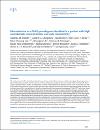Microdeletion in a FAAH pseudogene identified in a patient with high anandamide concentrations and pain insensitivity
| المؤلف | Habib, Abdella M. |
| المؤلف | Okorokov, Andrei L. |
| المؤلف | Hill, Beta Matthew Nicholas |
| المؤلف | Bras, Jose T. |
| المؤلف | Lee, Man-Cheung |
| المؤلف | Li, Shengnan |
| المؤلف | Gossage, Samuel J. |
| المؤلف | Drimmelen, Marie van |
| المؤلف | Houlden, Henry H. |
| المؤلف | Ramirez, Juan D. |
| المؤلف | Bennett, David L.H. |
| المؤلف | Srivastava, Devjit |
| المؤلف | Cox, James J. |
| تاريخ الإتاحة | 2021-10-05T10:09:02Z |
| تاريخ النشر | 2019-08 |
| اسم المنشور | British Journal of Anaesthesia |
| المعرّف | http://dx.doi.org/10.1016/j.bja.2019.02.019 |
| الملخص | The study of rare families with inherited pain insensitivity can identify new human-validated analgesic drug targets. Here, a 66-yr-old female presented with nil requirement for postoperative analgesia after a normally painful orthopaedic hand surgery (trapeziectomy). Further investigations revealed a lifelong history of painless injuries, such as frequent cuts and burns, which were observed to heal quickly. We report the causative mutations for this new pain insensitivity disorder: the co-inheritance of (i) a microdeletion in dorsal root ganglia and brain-expressed pseudogene, FAAH-OUT, which we cloned from the fatty-acid amide hydrolase (FAAH) chromosomal region; and (ii) a common functional single-nucleotide polymorphism in FAAH conferring reduced expression and activity. Circulating concentrations of anandamide and related fatty-acid amides (palmitoylethanolamide and oleoylethanolamine) that are all normally degraded by FAAH were significantly elevated in peripheral blood compared with normal control carriers of the hypomorphic single-nucleotide polymorphism. The genetic findings and elevated circulating fatty-acid amides are consistent with a phenotype resulting from enhanced endocannabinoid signalling and a loss of function of FAAH. Our results highlight previously unknown complexity at the FAAH genomic locus involving the expression of FAAH-OUT, a novel pseudogene and long non-coding RNA. These data suggest new routes to develop FAAH-based analgesia by targeting of FAAH-OUT, which could significantly improve the treatment of postoperative pain and potentially chronic pain and anxiety disorders. |
| اللغة | en |
| الناشر | Elsevier |
| الموضوع | anandamide anxiolytic endocannabinoids pain insensitivity postoperative analgesia |
| النوع | Article |
| الصفحات | e249-e253 |
| رقم العدد | 2 |
| رقم المجلد | 123 |
تحقق من خيارات الوصول
الملفات في هذه التسجيلة
هذه التسجيلة تظهر في المجموعات التالية
-
أبحاث الطب [1913 items ]



